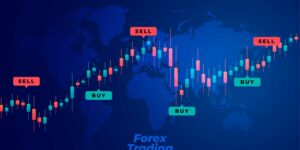Margin on forex trading is a fundamental concept crucial in determining the level of leverage and risk involved in a trade. It refers to the amount of funds required by a trader to open and maintain a position in the foreign exchange market. Understanding the concept of margin is essential for forex traders as it directly influences their ability to take on more significant positions and potentially amplify profits or losses.

What is Margin in Forex Trading?
Margin in forex trading refers to the collateral or deposit that traders are required to have in their trading accounts in order to open and maintain positions in the currency market. It is typically expressed as a percentage of the total position size and determines the level of leverage that traders can utilize.
Margin acts as a security deposit, providing a cushion for potential losses and ensuring that traders have sufficient funds to cover their positions. By using margin, traders can control larger positions with relatively smaller amounts of capital, which offers the potential for higher profits but also carries higher risks.
Margin Calculation: Initial Margin and Maintenance Margin
Margin calculation involves two key components: initial margin and maintenance margin. The initial margin refers to the amount of funds required to open a new position, typically expressed as a percentage of the total position size.
The maintenance margin, also known as the minimum margin requirement, represents the minimum amount of funds required to keep a position openMargin calculation takes into account the currency pair being traded, the leverage ratio, and the account denomination.
Understanding Leverage: The Relationship between Margin and Leverage
Leverage is closely tied to margin in forex trading. It refers to the ability to control larger positions in the market with a smaller amount of capital. Leverage is expressed as a ratio, such as 1:50, 1:100, or higher, indicating the multiple by which a trader can magnify their exposure to the market.
For example, with a leverage ratio of 1:100, a trader can control a position of $100,000 with a margin requirement of $1,000. Higher leverage amplifies both potential profits and losses, so it is crucial for traders to understand the risks involved and manage their positions accordingly.
Margin Requirements and Margin Calls
Brokers set margin requirements and represent the minimum amount of margin needed to open and maintain positions. These requirements can vary across different brokers and currency pairs. When the account equity falls below the maintenance margin level, brokers may issue a margin call.
A margin call requires traders to either deposit additional funds into their account or close out positions to bring the account equity back above the required margin level. It is important for traders to monitor their account balance and margin level to avoid margin calls and potential liquidation of positions.
Margin Level: Monitoring Account Health
The margin level is a metric that indicates the health and risk exposure of a trader’s account. It is calculated by dividing the account equity by the used margin and multiplying the result by 100 to get a percentage.
Margin level provides insight into the available margin relative to the used margin. A higher margin level indicates a healthier account with lower risk of margin calls, while a lower margin level suggests higher risk and potential margin calls. Traders should regularly monitor their margin level to ensure they have sufficient margin to sustain their positions.
Impact of Margin on Forex Trading Strategy
Margin has a significant impact on forex trading strategies. Higher leverage allows traders to take on larger positions and potentially generate higher returns. However, it also amplifies the potential for losses, making risk management and proper position sizing crucial.
Traders need to consider their risk tolerance, market conditions, and the potential impact of leverage on their trading strategies. Careful consideration of margin requirements and risk management techniques can help traders make informed decisions and mitigate the risks associated with high leverage.
Managing Margin Risks: Margin Call Prevention and Stop Loss Orders
To manage margin risks, traders can employ various techniques. One approach is to set stop loss orders, which automatically close out positions when a certain loss threshold is reached. Stop loss orders help limit potential losses and protect account equity. Additionally, traders can closely monitor their positions, regularly assess their margin level, and maintain sufficient account equity to avoid margin calls. Proper risk management strategies, including diversification, position sizing, and setting realistic profit targets, are essential for effectively managing margin risks in forex trading.
Different Types of Margin Accounts in Forex Trading
Forex brokers may offer different types of margin accounts to cater to the diverse needs of traders. Some common types include standard margin accounts, mini accounts, and micro accounts. Standard margin accounts typically require larger minimum deposits and allow for higher leverage ratios.
Mini accounts have lower minimum deposit requirements and often come with lower leverage ratios. Micro accounts are designed for traders with limited capital and offer the lowest minimum deposit requirements and leverage ratios.
Final Thoughts: Importance of Margin in Forex Trading
Traders should carefully assess their risk tolerance, employ proper risk management strategies, and monitor their margin levels to avoid margin calls and protect their account equity. By utilizing margin wisely and implementing sound trading practices, traders can harness the potential of margin to achieve their trading objectives.





